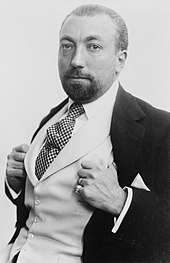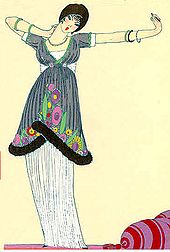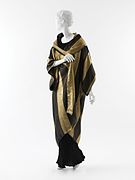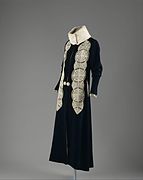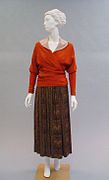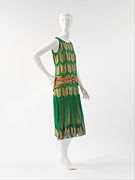Paul Poiret
Paul Poiret (born April 20, 1879 in Paris , † April 28, 1944 there ) was a French fashion designer .
Live and act
Poiret was the son of a cloth merchant and initially trained with an umbrella maker. Since he had been interested in fashion from an early age, however, he managed to sell some of his sketches to Louise Chéruit from the Raudnitz fashion house and he began to work as a freelance designer for the Grands Couturiers . At Jacques Doucet he familiarized himself with cutting and handling fabrics. Doucet also recommended him to actress Gabrielle Réjane , who promoted his work. After his military service, Poiret worked for Charles Frederick Worth and, since his designs were too extravagant for Worth customers, he set up his own salon in 1904.
Poiret was the first designer to come up with the idea of publishing his designs in the form of a fashion album. In 1908 Paul Iribe published Les Robes de Paul Poiret illustrated in an edition of 250 copies. In 1911 another album was released, this time illustrated by Georges Lepape .
When the Ballets Russes came to Paris in 1909 , he was inspired by the stage costumes to create oriental -looking, flowing robes. However, he denied that the costume drawings by the Russian Léon Bakst had a concrete influence on his designs. The orientalizing collection from 1913 included turbans and harem trousers as well as the so-called “lampshade dress”, the hem of which was stiffened with a wire hoop so that it surrounded the wearer in a ring.
In contrast to the designs of his colleagues, Poiret's models could also be worn without a corset for the first time and yet not only chic, but downright elegant - revolutionary for this time. He even propagated pant skirts, which until then were only accepted by cyclists.
In 1911, however, he took a step backwards (from an emancipatory point of view) by inventing the so-called hobble skirt . In the same year he founded the school Les Ateliers de Martine , named after his younger daughter Martine , in which young girls were trained to work according to the guidelines of the Wiener Werkstätte . The company was named Parfums de Rosine after the older daughter Rosine . With its fragrance creations based on Rose fragrances Paul Poiret is considered long before Coco Chanel as the creator of designer perfumes .
In 1914, shortly after the outbreak of the First World War , Poiret developed the first new military coat for the French army since 1877. After it had been established that all the colors of the fabric, even those of the tricolor, were imported from now warring Germany, the French army could only access the stocks of a German subsidiary. The original plan to weave a new uniform material in the French national colors red - white - blue had to be abandoned soon, since no confiscated red import color was available in sufficient quantities. The new coat fabric was woven in shades of indigo blue and white.
The later famous "horizon blue" look of the French soldier at the front was created by chance. Poiret introduced his new single-breasted cropped coat with button-down lapels and a soft collar in September 1914. Compared to the heavy predecessor model with its uncomfortable short stand-up collar, the lines of the fashion designer are clearly evident.
Poiret's style, which had close ties to Art Deco , was groundbreaking until the end of the First World War . After that, due to the economic decline of his fashion house , he had to clear the field for his fiercest competitor, an aspiring fashion designer named Coco Chanel . His memoirs appeared in 1930 under the title En habillant l'époque .
Poiret had already married 19-year-old Denise Boulet in 1905, whose slender figure differed considerably from the rather rounded Edwardian ideal and who became her husband's muse. He had five children with her. Denise divorced him in 1929. When Poiret died in oblivion in 1944, it was she who archived his designs and documented his work in decorative arts and interior design.
collection
Metropolitan Museum of Art , New York (selection)
See also
literature
- Rudolf Kinzel: The fashion makers, history of haute couture . Paul Zsolnay, Vienna, Darmstadt 1990, ISBN 3-552-04202-4 .
- Laurent Mirouze: Infantrymen of the First World War . Karl-Heinz Dissberger, Düsseldorf 1990, ISBN 3-924753-28-8 .
- Christie Mayer Lefkowith: Paul Poiret and His Rosine Perfumes . Stylissimo January, New York 2007, ISBN 978-0-9701800-1-8 (English, entry at "Library of Congress" [accessed July 20, 2009]).
- NJ Stevenson: The History of Fashion. Styles, trends and stars. Haupt, Bern u. a. 2011, ISBN 978-3-258-60032-1 , pp. 76-77
- King of fashion: the autobiography of Paul Poiret / Paul Poiret; translated by Stephen Haden Guest, London: V&A Publishing, [2019], "First published by JB Lippincott Company, 1931", ISBN 978-1-85177-961-1
Web links
- Search for "Poiret, Paul" in the SPK digital portal of the Prussian Cultural Heritage Foundation
- Literature by and about Paul Poiret in the catalog of the German National Library
Individual evidence
- ↑ Les robes de Paul Poiret. Racontées by Paul Iribe. Société Générale d'Impression, Paris 1908. 10 plates.
- ↑ Les choses de Paul Poiret . Maquet, Paris 1911
- ↑ Parfums De Rosine (English, July 20, 2009)
- ↑ Stevenson: The History of Fashion. Bern 2011, pp. 76–77
| personal data | |
|---|---|
| SURNAME | Poiret, Paul |
| BRIEF DESCRIPTION | French fashion designer |
| DATE OF BIRTH | April 20, 1879 |
| PLACE OF BIRTH | Paris |
| DATE OF DEATH | April 28, 1944 |
| Place of death | Paris |
